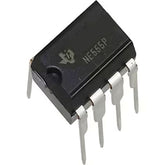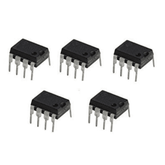Electronic Components as per Computer Generations
Summary
Explore the evolution of electronic components across computer generations in our latest blog. From the pioneering First Generation Computers (1940s-1950s) to the revolutionary Fifth Generation Computers (1980s-Present), we delve into the transformative journey of technology. Uncover the milestones, innovations, and breakthroughs that shaped each era, culminating in the present digital landscape. Join us on a captivating exploration through time and technology. Don't miss the insightful journey from the birth of computing to the cutting-edge advancements of today. Read on for a thrilling ride through the history of electronic components and their impact on computer generations.
Introduction
The electronic components utilized in computers have progressed remarkably across the different generations of computing technology since the 1940s. Each breakthrough in electronics enabled new capabilities that defined that generation of computers. Major electronics parts innovations aligned precisely with the emerging capabilities of each new computer generation.
First Generation Computers (1940s-1950s)
Vacuum Tube Circuits

The first generation of electronic computers in the 1940s and 1950s relied on extensive circuits composed of glass vacuum tubes. Vacuum tubes worked by heating a metal cathode filament that emitted a stream of electrons to be collected by a positively charged metal anode plate. Additional metal grids between the cathode and anode could be used to control and amplify the electron flow. Thousands of these primitive active electronic components formed the logic, processing, and memory functions in initial computer designs like the ENIAC - built at the University of Pennsylvania in 1946. The ENIAC utilized over 17,000 vacuum tubes and consumed 140 kW of power. However, vacuum tubes were relatively large, fragile, power hungry, and prone to failure - especially the filaments which burned out frequently. This inherently limited the capabilities of early computer systems.
Magnetic Drum and Core Memory

To supplement vacuum tube logic and volatile registers, first generation computers began utilizing magnetic drum and magnetic core memory technologies for non-volatile storage and recall of programming instructions and data. Magnetic drums coated the outside convex surface of a rotating metal cylinder with a ferromagnetic material. This coating could be polarized into distinct magnetized regions by a read/write head laying down magnetic domains - representing bits for binary data storage. Magnetic cores strung small ferrite rings on an x-y grid of wires. Running current pulses through the grid could set or reset the magnetic orientation of the rings at specific locations - enabling random access to store and retrieve data. Magnetic drums and cores were slower than vacuum tubes but enabled early computers to load programs and store data when powered off - greatly expanding capabilities. However, they still faced substantial size and performance restrictions in terms of access speeds and overall memory capacity - bottlenecks for computational work.
Second Generation Computers (1950s-1960s)
Transistors

The invention of the transistor at Bell Labs in 1947 represented the seminal breakthrough leading to second generation computing in the 1950s and 1960s. Transistors are active semiconductor electronic components that leverage modulations in charge carrier conductivity at the junction between differently doped regions of a crystalline germanium or silicon substrate to amplify or switch electric signals and power. Compared with hot fragile vacuum tubes relying on heated filaments, transistors offered superior reliability, frequency response, energy efficiency, scalability, and physical durability - tremendously advancing electronics. Early discrete transistors were soon integrated into circuits amplifying signals, powering logic gates, and forming the basic building blocks for entire central processing units (CPUs) that defined second generation computer systems. The expanding use of compact and efficient transistors led to major leaps forward in processing speed, memory capacity, size reduction, and affordability that opened up new applications in business, research, education, and defense.
Ferrite Core Arrays

In tandem with transistors, upgraded magnetic memory technologies also boosted second generation computer capabilities. Tiny ferrite core arrays became widely adopted - utilizing miniature ferrite rings wired together through precision x-y selector lines that could set and sense their magnetization state via coincident current pulses. This non-destructive readout allowed random access rather than purely sequential memory addressing. Ferrite cores operated at up to ten times the speed of early magnetic drums while retaining non-volatility. Their grid structure also enabled expanding memory capacities. As both CPU logic utilizing transistors and main memory via ferrite cores improved dramatically, this mitigated previous speed mismatches between processing and data access that constrained performance. Together these advances indicated the clear transition into second generation computing.
Third Generation Computers (1960s-1970s)
Integrated Circuits

The integrated circuit (IC) fundamentally transformed electronics and computing in the 1960s and 1970s by radically miniaturizing and integrating entire subcircuits onto single semiconductor chips. Rather than wiring together many discrete transistors, diodes, resistors, and capacitors - the chemical etching process central to IC fabrication allowed etching extremely small and dense individual circuit elements onto the silicon substrate which could then be interconnected via overlaid metal wiring layers. Early small-scale integration ICs packed dozens of electronics parts onto chips, soon advancing to large-scale ICs incorporating thousands then tens of thousands of transistors - enabling entire microprocessors on single die. ICs represented major strides forward regarding functionality per unit volume/cost along with speed, reliability, and power efficiency. Their rapidly expanding capabilities fueled exponential advances in processing, memory, programmability, size reduction, and affordability - hallmarks of the third computer generation.
RAM and ROM Memory

With integrated circuits also came new forms of electronic memory displacing earlier magnetic cores - random access memory (RAM) and read only memory (ROM). Static and dynamic RAM serve as the primary volatile storage interfaced with the CPU - relying on tiny flip-flops or capacitors integrated onto memory chips rather than magnetic states. This allows much faster access speeds in the nanoseconds range along with vastly higher storage density scaling with Moore's Law applied to transistor counts in memory ICs. Read only memory consists of predefined unalterable data or programming instructions stored within the electronic memory array during manufacturing - useful for firmware, mathematical functions, or data tables needed by software routines. From initially kilobit chip capacities in the early 1970s, RAM and ROM memory progressed to megabit densities by the 1980s - propelling exponential computing advances via massively expanded memory.
Fourth Generation Computers (1970s-1980s)
Microprocessors

The microprocessor drove fourth generation computing by delivering the final piece enabling entire central processing units contained on single integrated circuit chips. Following the pioneering 4-bit Intel 4004 in 1971, microprocessor capability and complexity grew enormously within a decade - allowing these complex ICs to integrate not just arithmetic logic units for computational operations but also control circuitry, registers, data buses, memory interfaces and clock timing onto single die. Microprocessors represented the radical miniaturization/distribution of computing functionality that were the hallmarks of the fourth computer generation - enabling affordable personal computers and workstations alongside industrial/embedded systems, laser printers, point-of-sale terminals, early gaming consoles, and much more. No longer restricted solely to university/corporate settings, microprocessors brought flexible and powerful computational resources into small offices and homes - revolutionizing lifestyles and productivity worldwide.
Winchester Hard Disk Drives

Advanced secondary storage capacity matched the leap in processing power enabled via single-chip microprocessors. This was delivered by Winchester hard disk drives - sealed units with smooth rapidly rotating aluminum or glass platters coated with a magnetic data recording surface accessed by low-floatation read/write heads. The Winchester drive design provided gigabyte range capacities for early personal computers - allowing operating systems, software applications, and user data storage previously out of reach. Capacities grew rapidly from initial 10-20MB drives in the late 1970s to over a gigabyte by the late 1980s alongside expanding drive interface speeds - keeping pace with the exponential CPU and memory improvement curves that defined fourth generation computing systems.
Fifth Generation Computers (1980s-Present)
Microcontrollers and Systems-on-Chip

Continuing exponential gains in the density of integrated circuits thanks to Moore's Law led to fifth generation computing - transitioning from incorporating just the CPU to entire computers contained within single microchip dies during the 1980s and beyond. Single chip microcontrollers integrate CPUs together with memory circuits, timing sources, peripheral controllers, programmable input/output pins, and other support logic optimized for embedded applications - revolutionizing ubiquitous computing deployed in vehicles, appliances, sensors, power tools, toys, and practically any other modern equipment. Likewise, staggeringly complex system-on-chip designs now integrate CPU cores alongside graphics processors, video encoders, network interface controllers, digital signal processing blocks, math co-processors, multimedia codecs, and general purpose I/O taking advantage of transistor budgets exceeding billions on leading edge semiconductor processes - enabling today's incredible mobile computing experiences.
Solid State Drives

Even as single chip electronics achieved incredible feats, underlying data storage technology has also continued rapidly advancing. Today's solid state drives (SSDs) - relying on integrated non-volatile flash memory rather than mechanical hard disks - with capacities exceeding 16 terabytes while delivering higher resilience, data rates, access speeds, and vastly lower latency. SSDs consume a fraction of the power required by earlier electromechanical storage solutions. These combinatorial benefits make SSDs ideal replacements enhancing everything from mobile devices to server farms - aligned with the capabilities of fifth generation computing systems. Looking even farther ahead, storage bounds stand to be upended once again with commercialization of exotic memory technologies relying on quantum, photonic, holographic, or even biological computing principles currently under development - potentially ready for future generations.
Conclusion
The key electronic building blocks enabling computers have thus progressed remarkably from the humble beginnings of ENIAC’s vast racks of primitive vacuum tubes to the incredibly powerful and intricate integrated circuits which drive today’s laptops, smartphones and cloud data centers. Each generational shift - through transistors, planar fabrication processes, microprocessors, microcontrollers, and contemporary chip-scale electronic systems - brought orders of magnitude improvements in capability, economy, reliability, programmability and accessibility of computing resources.
There remains vast room for continued rapid progress in line with Gordon Moore’s prediction that transistor density doubles approximately every two years - as integrated circuit designers continue pushing fabrication technology limits while exploring creative solutions to build ever more complex and tiny logic devices. This perseverant exponential electronic evolution promises to bring even more astonishing computing feats powering innovations we can just begin to imagine. The future remains scintillatingly bright for enterprising engineers, businesses, and consumers as new electronic milestones enable novel applications and even entirely new industries relying on ubiquitous high performance computing.











